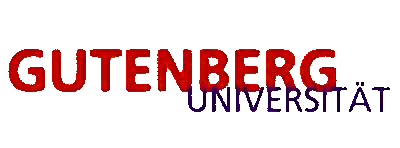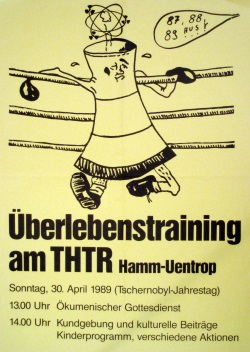 The KiKK study
The KiKK study
German Childhood Cancer Registry
Head: Dr. Peter Kaatsch
Epidemiological study of childhood cancer in the vicinity of nuclear power plants
(KiKK study)
final report
Summary
Part 1 (case-control study without questioning)
Part 2 (case-control study with questionnaire)
Peter Kaatsch, Claudia Spix, Sven Schmiedel, Renate Schulze-Rath, Andreas Mergenthaler, and Maria Blettner
Funded by the Federal Ministry for the Environment, Nature Conservation and Nuclear Safety through the Federal Office for Radiation Protection (project StSch 4334)
Institute for Medical Biometry, Epidemiology and Computer Science (IMBEI)
![]()
at the Johannes Gutenberg University Mainz

Director: Prof. Dr. Maria Blettner
Project leader: Dr. P. Kaatsch
Project coordination: Dr. habil. C. Spix
Overall advice: Prof. Dr. M. Blettner
Mainz, October 2007
The project on which this report is based was funded by the Federal Ministry for the Environment, Nature Conservation and Nuclear Safety under the grant number StSch 4334.
Employees
Project leader Dr. rer.physiol. Peter Kaatsch Project Coordinator Dr. rer.nat. et med.habil. Claudia Spix
Scientific advice Prof. Dr. rer.nat. Maria Blettner Prof. Dr. med. Jörg Michaelis Dr. rer.physiol. Joachim Schüz
Scientific project staff (temporarily) Dipl. Soz. Andreas Mergenthaler Jun.Prof. Dr. oec.troph. Eva Münster Dipl. Stat. Sven Schmiedel Dr. med. Renate Schulze-Rath
Other project team members (temporarily) Ms. Irene Jung Ms. Melanie Kaiser Ms. Sabine Kleinefeld Ms. Claudia Trübenbach
Student assistants Ms. Jutta Albrecht Mr. Carsten Hornbach Mr. Steffen Weinand
Interviewer Ms. J. Albrecht Ms. A. Becht Ms. B. Grossmann Mr. B. Haupt Mr. B. Krey Mr. L. Krille Mr. F. Müller Ms. P. Quetsch Mr. Dr. R. Schmunk Ms. R. Tekie Ms. C. Varlik
Summary
question
Beginning in 2003, an epidemiological case-control study was carried out at the German Children's Cancer Registry (DKKR) to investigate whether cancer is more common in children under 5 years of age in the immediate vicinity of nuclear power plants than in greater distances. This study was motivated by a series of exploratory evaluations of earlier studies by the DKKR, in which the cancer incidence in children near German nuclear power plants was investigated using other methods. This was followed by exploratory analyzes by third parties of data from the DKKR. This data was used and published by the BfS for its own investigations, primarily for environmental health reporting.
The new study consists of two parts: Part 1 is a case-control study without contacting cases and controls, for Part 2 a questionnaire was carried out on a subgroup. The design of the study was determined in consultation with a committee of experts put together by the Federal Office for Radiation Protection (BfS). The hypothesis of the study (in the sense of the statistical null hypothesis) reads: “There is no connection between the proximity of the home to a nuclear power plant and the risk of developing cancer up to the age of 5. There is no negative trend in the distance of the disease risk. "
Methodology
A case-control study was carried out. Part 1 includes all children diagnosed with cancer between 1980 and 2003 who were reported to the German Childhood Cancer Registry, who were under 5 years old at the time of diagnosis and who lived in regions around 16 German nuclear power plants specified in advance (1592 cases). For each case, controls of the same gender and age in the year of illness were randomly selected from the same region (4735 controls). For the cases, the individual distance from the apartment to the nearest nuclear power plant on the day the diagnosis was made was determined, for the controls on an analogous reference date.
For part 2 of the study, a subset of the cases and controls from part 1 were asked about possible risk factors that could possibly act as confounders and about their residential history. For this purpose, the cases diagnosed between 1993 and 2003 under the age of 5 who had leukemia, lymphoma or a CNS tumor (CNS: central nervous system) and were living in the study region at the time of diagnosis were selected. The controls assigned to these cases in Study Part 2 were used as controls in Part 1.
Results
Data material
The processes for obtaining the addresses of cases and controls and their geocoding could largely be carried out as planned. Missing or imprecise information was kept within narrow limits. The specification of an accuracy of the distance between apartments to be determined to the nearest nuclear power plant of at least 100 meters was met with an estimated average accuracy of around 25 meters.
During control recruitment, it emerged that municipalities in the vicinity of nuclear power plants were less cooperative in providing control addresses than those located further away (84% provided control addresses compared to 90% otherwise).
The willingness to participate in the survey in Part 2 was 78% in the cases and 61% in the controls. The ratio for cases and controls of 1: 2 aimed at for the survey was achieved.
A validation of the survey information by comparison with copies of medical documents (maternity record, child medical examination booklet, vaccination card) was carried out for a random sample of participants in the survey. It was shown that the information given in the interview for vaccinations and birth-related data (birth weight and height, week of pregnancy) agree well with the documents.
A comparison of participants and non-participants in the survey showed that families for whom the survey date (time of diagnosis in case children, KiKK study summary
corresponding reference date for control children) was a long time ago (1993-1995, around 10 years before the interview), participated somewhat less often. The distance to the nearest nuclear power plant had the clearest influence on willingness to participate: In the inner 5 km zone, willingness to participate was significantly lower, in controls (46% compared to 62% outside) it was even more pronounced than in cases (63% compared to 79%) outside of). We interpret this to mean that the families who live in the immediate vicinity of a nuclear power plant are very well aware of this fact and are therefore reluctant to take any questions. A short questionnaire was sent to all potential participants in the survey in Part 2. There are indications that families with a higher social status, especially in the controls, are more willing to participate. This phenomenon is known from other epidemiological and empirical studies (in Germany and internationally).
Confirmatory analysis
The main hypothesis for Part 1, that there is no monotonically decreasing relationship between the distance from the home to the nearest nuclear power plant and the risk of illness, is rejected at the one-sided level α = 5%. 1 / r was previously defined as the distance measure, where r is the distance between the residential address and the nearest nuclear power plant. The regression analysis yielded an estimate for the regression coefficient of βˆ = 1,18 (lower one-sided 95% confidence limit = 0,46, ie statistically significantly different from zero). The evaluation of the secondary question, in which the distance is categorized, also shows a statistically significant result for the 5 km zones around the nuclear power plants (odds ratio (OR) = 1,61, lower one-sided 95% confidence limit = 1,26).
In the diagnosis subgroups, the leukaemias (593 cases, 1766 controls) show a statistically significant estimate for the regression coefficient of βˆ = 1,75 (lower one-sided 95% confidence limit = 0,65). The effect observed for the subgroup of all leukemias is stronger than for all malignancies as a whole. The examined subgroups of leukemia each show similar values. However, this is only statistically significant for acute lymphatic leukemia
edge. The number is too low for acute myeloid leukemia (75 cases, 225 controls). In the other diagnostic subgroups defined a priori (CNS tumors, embryonic tumors), no indications of a relationship to the distance were found. From this it can be concluded that the effect observed for all malignant diseases is essentially due to the results of the relatively large subgroup of leukemias.
There is no statistically significant difference between the regression coefficients in a priori defined sub-periods (first half of the respective reactor running time compared to the second half) (p = 0,1265).
The subgroup of cases and controls that was written to for part 2 of the study (471 cases, 1402 controls) shows no relevant difference compared to the regression parameter determined for the entire group of part 1 (estimated coefficient 11% smaller than in the overall model). However, the group of people who then took part in the interview differed greatly from the group as a whole.
A statistical criterion was specified in the evaluation plan, according to which it was checked whether the participants in the telephone interview (part 2) were possibly a non-representative selection from the cases with the corresponding diagnosis from part 1 and the associated controls. In this case, the results of Part 2 cannot be used to interpret the results of Part 1. This criterion was met, ie the data from the survey in Part 2 of the study cannot be used to check whether the results of Part 1 are distorted by potential confounders. The main reason for this is the low willingness to participate in the inner 5km zone.
Sensitivity analysis and exploratory analysis
A number of planned sensitivity analyzes and exploratory analyzes based on the available data were carried out. Overall, there was no indication of a relevant influence on the results. Most sensitivity analyzes tend to indicate a slight overestimation of the reported effect. The planned exploratory analysis of the shape of the regression curve using fractional polynomials and a Box-Tidwell model gave no indication of a fundamentally different shape of the regression curve than that provided in the evaluation plan.
Since the provision of control addresses was less complete from the communities located near nuclear power plants than from those located further away, a sensitivity analysis was also carried out on this in addition to the specifications of the evaluation plan. The potential bias from this problem in control recruitment is minor.
The survey in Part 2 of the study on residential history showed that some of the control families had not lived at the address originally given by the registration office at any time before the reference date, but only afterwards. This is to be explained by the municipalities on incorrectly delivered control addresses. Simulation calculations as well as the extended evaluation of documents from the control drawing and the letter of a random sample from the municipalities showed that the result of the study is only marginally influenced by this.
The omission of a single nuclear power plant region (each for all malignancies and leukemia) did not indicate that the result only depends on a single region. In connection with the intensive discussion in Germany on the incidence of leukemia among children near the Krümmel nuclear power plant (due to 17 cases of illness between 1990 and 2006 in two directly neighboring communities), it should be noted that 8 of these cases belong to the study population in the inner 5km Zone belong. For leukemia, the study result is most strongly influenced by the region around the Krümmel nuclear power plant. If these cases and the corresponding controls are omitted, the estimate for the regression coefficient in the leukemia subgroup is βˆ = 1,39 (lower one-sided 95% confidence limit = 0,14).
Confounder analyzes
The results of Part 2 cannot be used to interpret the results of Part 1, as the willingness to participate, depending on the proximity to the nuclear power plant, led to a selection. At the request of the BfS and the advisory panel of experts, a multivariate KiKK study summary regression analysis with the variables surveyed (confounder analysis) was carried out. As originally planned, it was checked whether the consideration of the potential confounders changes the estimator for the regression coefficient of the distance measure (change-in-estimate principle). Checking this was the motivation for carrying out Part 2 of the study at the time. None of the variables led to a change in the estimator that exceeded the previously determined order of magnitude (± 1 standard deviation). An exploratory evaluation of the confounders, for which this study was not designed, revealed relationships that largely confirm the results known from the literature.
Attributable Risks
For the years 1980-2003 and the number of cases observed in the 5 km zone under consideration (n = 77), there is an attributable risk for Germany of 0,2% for living within the 5 km zone around one of the 16 nuclear power plants. This means that 29 of the 13.373 cases of cancer diagnosed with cancer in Germany in the period 1980-2003, i.e. 5 cases per year, would be attributable to living within the 1,2 km zone around a German nuclear power plant under the model assumptions made . In relation to the leukemia, of which 5 were observed between 37 and 5 between 1980 and 2003 in the inner 5 km zones, we calculate a population-attributable risk of 0,3%, that would be 20 of the 5.893 cases under 5 years in Germany, which were diagnosed in the years 1980-2003, and thus 0,8 cases per year. Because of the small number of cases on which they are based, these estimates are subject to considerable uncertainty.
discussion
Survey Design
The KiKK study is a case-control study in children under the age of 5 who had cancer from 1980-2003, in which it was examined whether there is a connection between the distance from home to the nearest nuclear power plant and the risk of developing cancer . The strength of this study can be seen in the fact that, in addition to the previous nuclear power plant studies carried out in Germany, which were based on aggregated incidence rates in distance regions, it uses an individual measure of distance based on the distance between houses and the nearest nuclear power plant.
The survey of a pre-determined group of parents of case and control children, which was integrated into the study, was intended to help take possible confounders into account so that they could be used to evaluate the study results. Unfortunately, this evaluation was not possible or could not be assessed due to the response behavior of the study participants. However, hardly any risk factors are known from the literature to date that could act as correspondingly strong confounders.
Radiation epidemiological aspects
The present study looks at the distance to the nearest nuclear power plant. Data on environmental radiation exposure were not used because they are not available and cannot be collected retrospectively. It was also not taken into account that individuals are not constantly in the same place and that they are also exposed to other radiation sources in addition to the background radiation
(e.g. terrestrial radiation, medical diagnostics, air travel). Different topographical or meteorological conditions (e.g. precipitation, wind direction) could also not be taken into account.
The distance from the house to the nearest nuclear power plant at the time of diagnosis (control: diagnosis date of the relevant case) was used for each individual. Taking into account relocations in the period from conception to diagnosis requires a survey of the families and was therefore not possible for the majority of the families included in the study.
On the basis of a predefined model, a distance measure was formed, for which a regression curve was estimated. The distance measure is based on theoretical dispersion models, the regression model follows the usual linear model for the low dose range. However, this model is based on studies that assessed the risk of cancer in adults in relation to ionizing radiation. Adults mainly develop solid tumors, while systemic diseases are relatively more common in children. The extent to which models of the effect of low-dose radiation on new leukemia diseases in children of preschool age can be transferred has not yet been clarified in the international literature.
The currently internationally used estimates of radiation effects in the low dose range are based on a linear extrapolation downwards without a threshold value; a quadratic model can also be used for leukemia. Other authors assume that these models considerably overestimate the effects in the dose range of <0,01 Sv (Sievert). Special statements for children are not made in the corresponding reports, or the corresponding data situation is described as inadequate for this. For example, the models indicate an excess relative risk, which can be compared with the OR-1 variable from this report, of approx. 0,5 per 1 Gy / year (one gray (Gy) here corresponds to one sievert). The limit value for the exposure of people in the "vicinity" of nuclear facilities in Germany is 0,3 mSV (milli Sievert) per year. The actual loads are far below that. For example, a 50-year-old person whose residence is 5 km from the nuclear power plant is expected to have a cumulative exposure to airborne emissions of 0,0000019 mSv (milli Sievert) (Obrigheim) to 0,0003200 mSv (Gundremmingen). The annual natural radiation exposure in Germany is around 1,4 mSv, the average annual exposure from medical examinations around 1,8 mSv. In contrast, exposure to ionizing radiation near German nuclear power plants is 1.000 to 100.000 times lower. Against this background, according to the current state of scientific knowledge, the result of our study cannot be explained in terms of radiation biology.
Comparison with earlier German nuclear power plant studies
Before the present study was carried out, two studies with incidence comparisons were carried out at the German Childhood Cancer Registry in connection with nuclear power plants. In a first study (“Study 1”), the incidence of all under 1980-year-old cases diagnosed between 1990 and 15 in the 15 km zone around 20 German nuclear power plants was compared to demographically similar comparison regions. The study was motivated by conspicuous results within a 10 mile radius of British nuclear power plants (Sellafield, Windscale) and examined all diagnoses between the ages of 0-14 years in a 15 km zone as the main question. There was no increased risk (RR 0,97; 95% CI [0,87; 1,08]). Age subgroups, distance regions and diagnosis subgroups were examined in the form of exploratory analyzes. The additional exploratory results were checked in a follow-up study (“Study 2”) with the same design using independent data from the years 1991-1995 updated over time. The main question (all diagnoses, age 0-14, 15 km zone) remained, the corresponding result was normal (RR 1,05; 95% CI [0,92; 1,20]). The exploratory significant results from the first study, especially the question about leukemia under 5 years in the 5 km zone, now showed somewhat smaller relative risks and were not statistically significant. Accordingly, this was assessed as a non-confirmation of the exploratory results.
The studies of that time and the current study overlap, especially in the close range with regard to the cases and the study region. Compared to the earlier studies, the BfS expert committee excluded the nuclear facilities Kahl, Jülich, Hamm, Mühlheim-Kärlich and Karlsruhe from the current study. These are essentially research reactors or nuclear power plants with a short operating life. Of the cases now included in the inner 5km zone under the age of 5 years, around 1% were already taken into account in studies 2 and 70, 80% of the cases from the previous studies are also taken into account again in the current study. In addition to the exclusion of some nuclear facilities, the discrepancy is essentially based on the additional observation years (1996-2003) and the changed definition of the perimeter. At that time, municipalities were assigned a total of 5, 10 or 15 km zone according to the location of their area and no individual house coordinates were used.
Comparable to the result of the main question at that time (age up to 15 years, 15 km zone), when considering all malignancies in under 5 year olds in the inner 5 km zone from the first studies, the conclusion that there was an increased risk did not come to the conclusion that there was an increased risk, because the effect estimators were not statistically significant (tested on both sides). With the approach of the current study, a statistically significant increase in the risk was found (tested on one side).
The result that was most discussed at the time and that emerged from the exploratory data analysis of the former Study 1 (relatively significant increase in risk for acute leukemia in the age under 5 in the 5 km zone) is more similar to the current study based on the extended period 1980-2003 Order of magnitude confirmed. For leukemia, the influence of the results at that time on the current results is very clear. The risk estimate determined in Study 1 for the period from 1980-1990 is almost identical to that determined for the same period in the current study. The odds ratio for the period following the two earlier studies (1996-2003) is lower than for the previous periods.
In study 1, this was an exploratory result and was therefore less important than the confirmatory analyzes within the same study. In the study that was intended to check this (Study 2), the significant result was not confirmed, but the relative risk was increased. In the current study, the same question was examined again as a secondary question, this time a statistically significant result was found.
Conclusion
Our study has confirmed that in Germany there is a connection between the proximity of the home to the nearest nuclear power plant at the time of diagnosis and the risk of developing cancer (or leukemia) before the age of five. This study cannot make any statement about which biological risk factors can explain this relationship. Exposure to ionizing radiation was neither measured nor modeled. Although earlier results could be reproduced with the current study, the ionizing radiation emitted by German nuclear power plants during normal operation cannot be interpreted as the cause due to the current radiation-biological and epidemiological knowledge. Whether confounder, selection or chance play a role in the observed distance trend cannot be conclusively clarified with this study.
(Release of atomic radiation since the early 1940s: see INES - The international rating scale and list of nuclear accidents worldwide)
- The map of the nuclear world -
back to the
Donation appeal- The THTR-Rundbrief is published by 'BI Umwelt Hamm e. V. ' issued and financed by donations. - The THTR circular has meanwhile become a much-noticed information medium. However, there are ongoing costs due to the expansion of the website and the printing of additional information sheets. - The THTR circular researches and reports in detail. In order for us to be able to do that, we depend on donations. We are happy about every donation! Donations account:BI Umweltschutz Hamm |





 From uranium mining and processing, to nuclear research, the construction and operation of nuclear facilities, including accidents in nuclear power plants, to handling uranium ammunition, nuclear weapons and nuclear waste.
From uranium mining and processing, to nuclear research, the construction and operation of nuclear facilities, including accidents in nuclear power plants, to handling uranium ammunition, nuclear weapons and nuclear waste.
